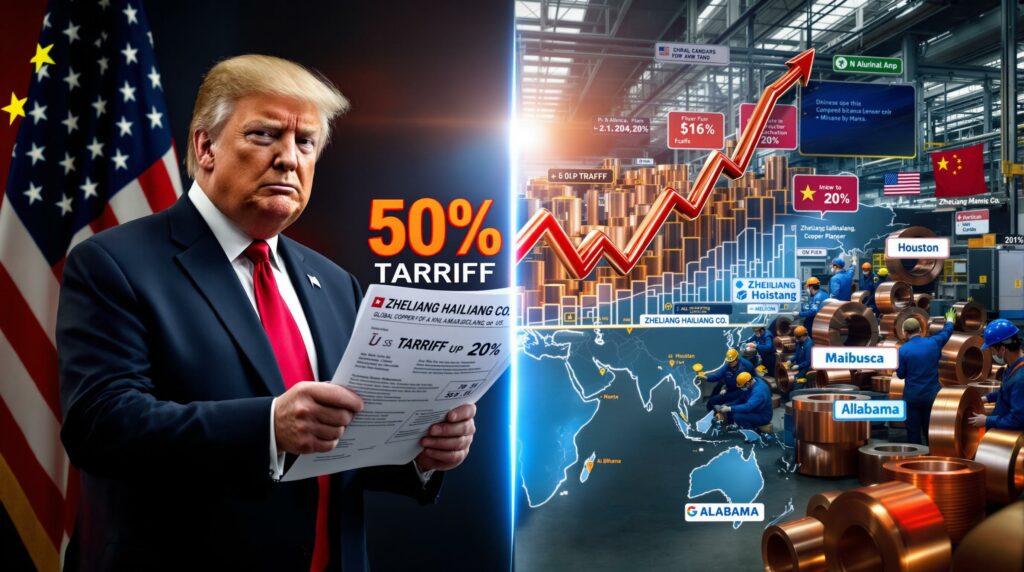Understanding Trump's Copper Tariffs and Their Global Impact
The global copper market has been significantly disrupted by the Trump administration's recent imposition of a 50% duty on semi-finished copper imports. These tariffs, implemented at the end of July 2025, target imports valued at more than $15 billion annually, creating ripple effects throughout global supply chains and manufacturing networks. Understanding the trump tariff implications is crucial for investors and industry stakeholders alike.
The scope of these tariffs is expected to expand further, as the White House has directed officials to develop a plan within 90 days to apply similar tariffs to a broader range of copper-intensive goods. This represents a substantial escalation in protectionist trade policy aimed at reducing American dependency on foreign copper products.
U.S. Copper Import Dependency Exposed
The United States imported approximately 600,000 tonnes of semi-finished copper in 2024, accounting for nearly one-third of total U.S. demand according to analysis from Citic Securities. This substantial reliance on imports highlights a significant vulnerability in America's industrial supply chain.
The tariffs expose a critical weakness in U.S. domestic copper manufacturing capacity, which has declined over decades as production shifted to lower-cost regions. While designed to incentivize domestic production, the immediate effect has been market disruption and uncertainty for industries relying on copper inputs.
Industry experts note that rebuilding domestic copper manufacturing infrastructure will require significant time and investment. The gap between current production capacity and market demand cannot be bridged quickly, creating potential supply challenges in the near term as global copper supply faces increasing pressure.
The Unexpected Chinese Winner: Zhejiang Hailiang Co.
While trade barriers typically disadvantage foreign manufacturers, one Chinese copper producer has turned potential adversity into opportunity. Zhejiang Hailiang Co., a major Chinese copper manufacturer, has seen its stock jump nearly 20% since the tariff implementation, significantly outperforming both other Chinese copper producers and the broader CSI 300 Index.
This remarkable market performance stems from Hailiang's strategic foresight in establishing manufacturing operations within the United States years before the tariffs were implemented. The company's international manufacturing footprint has provided a competitive advantage that few of its Chinese competitors can match.
Hailiang's Strategic U.S. Manufacturing Presence
The cornerstone of Hailiang's tariff-resistant strategy is its Houston manufacturing plant, established in 2020 with an initial production capacity of 30,000 tonnes annually. The facility produces copper tubes used in automotive applications, air conditioning systems, and plumbing infrastructure.
Even more significant are the company's expansion plans, which target 100,000 tonnes of annual production capacity at the Houston facility. This forward-looking investment positions Hailiang to capture a substantial portion of the U.S. market that was previously served by imports.
According to analysis from Citic Securities, Hailiang's U.S. factory is poised to deliver "exceptional profits" as a direct result of the tariffs. With import competition facing a 50% price disadvantage, the company's domestic U.S. production can command premium pricing while maintaining a competitive advantage over imports.
This strategic positioning demonstrates how sophisticated global supply chains can adapt to trade barriers when companies maintain flexible, geographically diversified manufacturing operations. The current copper price outlook further incentivizes such strategic positioning.
Global Manufacturing Adaptation Strategies
Hailiang's success illustrates a broader trend among forward-thinking manufacturers: geographic diversification as a hedge against trade uncertainty. The company has strategically positioned manufacturing bases across multiple continents, including operations in:
- United States (Houston)
- Indonesia
- Morocco
- China (headquarters)
This international expansion serves multiple strategic purposes beyond simply avoiding tariffs. It hedges against China's gradually slowing domestic economy, mitigates risks posed by ongoing trade tensions with Western countries, and ensures direct market access in key consumption regions.
Challenges in International Manufacturing Expansion
Despite its strategic advantages, Hailiang's international expansion has not been without challenges. The company's Houston plant reported a net loss of 35 million yuan ($4.9 million) in 2024, highlighting the difficulties of establishing profitable operations in new markets.
Several factors contributed to these initial losses:
- Higher labor costs in the U.S. compared to Asian manufacturing centers
- Increased material costs affecting production economics
- Significant expenses related to facility expansion and capability development
These challenges reflect the reality that international manufacturing diversification requires substantial upfront investment before delivering returns. The company's stock performance suggests investors view these short-term losses as necessary investments in long-term strategic positioning rather than as operational failures.
Copper industry analysts point out that establishing competitive manufacturing operations in high-cost regions typically requires a 3-5 year timeline to achieve profitability, making Hailiang's approach a long-term strategic bet rather than a quick response to trade tensions. Investors interested in the sector should consider various copper investment strategies to navigate this changing landscape.
Strategic Acquisitions and Market Positioning
Beyond organic expansion, Hailiang has pursued strategic acquisitions to strengthen its U.S. manufacturing presence. In December 2024, the company announced plans to acquire an undisclosed stake in Golden Dragon Precise Copper Tube Group, which operates a copper tube manufacturing plant in Pine Hill, Alabama, according to reports from Credendo.
This acquisition strategy accomplishes several objectives simultaneously:
- Accelerates U.S. manufacturing capacity expansion
- Diversifies geographic production footprint within the U.S. market
- Acquires established customer relationships and distribution channels
- Gains access to additional technical expertise and manufacturing know-how
Such acquisitions represent a sophisticated response to changing trade dynamics, allowing Chinese manufacturers to maintain market access despite increasingly restrictive tariff barriers.
Financial Impacts of Trade Adaptation
The costs of international expansion and tariff adaptation are reflected in Hailiang's recent financial performance. The company reported that its companywide net income dropped 37% to 703 million yuan in 2024, largely due to expenses related to its international expansion initiatives.
However, the market's response to these numbers has been strikingly positive. Rather than punishing the company for declining profits, investors have bid up the stock price, reflecting confidence that:
- Short-term profit declines represent investments in future growth
- Tariff-resistant manufacturing capacity will deliver superior returns
- Geographic diversification creates sustainable competitive advantages
- First-mover advantages in U.S. manufacturing will yield lasting benefits
This investor response highlights the importance of long-term strategic planning in navigating trade barriers, even when such strategies create temporary financial pressures. Meanwhile, the ASX copper stocks impact has been varied, with companies demonstrating different levels of adaptability.
The Future of Copper Manufacturing Under Trade Restrictions
As trade barriers reshape global supply chains, copper manufacturing appears likely to undergo several fundamental transformations. Industry experts anticipate:
- Increased localization of manufacturing in end-user markets
- Premium pricing for domestically produced copper products
- Accelerated manufacturing investment in tariff-free regions
- Industry consolidation as smaller players struggle with trade barriers
These changes will create both winners and losers within the industry. Companies with the financial resources, technical expertise, and strategic foresight to establish multi-regional manufacturing networks will likely thrive, while those dependent on export-based business models may struggle to maintain market access.
Broader Economic Implications
The tariffs will create complex ripple effects throughout the U.S. economy, as detailed by The Financial Review:
- Higher costs for U.S. consumers of copper-intensive products (including plumbing, electronics, and automotive components)
- Potential job creation in U.S. copper fabrication sector
- Reduced competitiveness for U.S. manufacturers using copper inputs
- Possible retaliatory measures from China affecting other industries
Economists remain divided on whether the tariffs will achieve their stated goal of rebuilding U.S. manufacturing capacity. While they create immediate incentives for domestic production, successful manufacturing ecosystems require more than just tariff protection – they need skilled labor, supplier networks, and technical expertise developed over time.
The experience of companies like Hailiang suggests that foreign manufacturers with existing U.S. operations may be better positioned to benefit from tariffs than new domestic entrants, potentially undermining the policy's intended beneficiaries.
FAQ: Chinese Copper Manufacturing and U.S. Tariffs
How large is the global semi-finished copper market?
The global market for semi-finished copper products exceeds $150 billion annually, with China producing approximately 60% of the world's supply. The U.S. imports valued at $15 billion represent a significant but limited portion of this market.
Will tariffs succeed in rebuilding U.S. copper manufacturing capacity?
While tariffs create short-term incentives for domestic production, building competitive manufacturing capacity requires substantial investment, skilled labor development, and time. Companies with existing U.S. operations like Hailiang have a significant advantage over new market entrants.
How might copper prices be affected by these trade policies?
Trade restrictions typically create regional price disparities, with protected markets seeing higher prices than global averages. U.S. copper fabricators may face higher input costs, while manufacturers with U.S. facilities could benefit from premium pricing.
What alternatives do U.S. buyers have to Chinese copper imports?
Major alternative suppliers include producers in Japan, South Korea, Germany, and emerging manufacturers in Southeast Asia. However, China's scale and cost advantages have made it difficult for these alternatives to fully replace Chinese supply.
Investment Perspective: Investors should watch for companies with geographic manufacturing diversity that can navigate tariff barriers while maintaining access to key markets. Firms with established U.S. operations prior to tariff implementation may be particularly well-positioned.
Industry Outlook: The copper fabrication sector is likely to see accelerated consolidation as trade barriers increase operational complexity and favor larger players with multi-regional manufacturing footprints. Smaller players may need to specialize in niche applications or risk market share erosion.
Ready to Stay Ahead of Mineral Discovery Opportunities?
Discover how the proprietary Discovery IQ model can instantly alert you to significant ASX mineral discoveries, transforming complex data into actionable investment insights. Visit our dedicated discoveries page to understand how major mineral discoveries have historically generated substantial returns for early investors.




